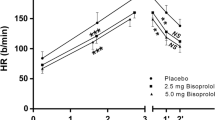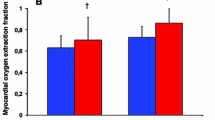Summary
Six male non-endurance trained subjects (S) and six marathon runners (M) underwentgraded treadmill exercise (T) andisoproterenol stimulation (I; 2 and 4 Μg·min−1),β-adrenergic receptor density was additionally determined as the amount of3H-Dihydroalprenolol (DHA) specifically bound on intact polymorphonuclear leucocytes. Heart rate,\(\dot V_{{\text{O}}_{\text{2}} }\) uptake, lactate, plasma noradrenaline, and adrenaline were estimated during T. Heart rate, stroke volume, cardiac output, as well as lactate, glucose, free fatty acids (FFA), and glycerol levels in the blood were determined during I. M showed the known training-dependent responses during T, such as lower heart rates, lactate levels, and plasma catecholamines at identical work loads, as well as higher\(\dot V_{{\text{O}}_{\text{2}} {\text{max}}}\) than S. I-induced cardiac output increase was quite similar in both groups. Stroke volume, however, increased significantly in M and stayed constant in S. Lactate decreased (S), glucose increased significantly (M), glycerol increased similarly in both groups, FFA rise was less marked in S. I-induced stroke volume response (I) may be indicative of a more economic regulation of heart work in M than S. Lactate decrease and less marked FFA increase, as observed in S, may be the result of a somewhat higher cardiac energy demand, dependent on less economic heart work. Higher DHA-binding as observed in M, as well as stroke volume response and glucose increase, may be indicators of a training-dependent rise in sensitivity to catecholamines. The unsolved question is, however, to what extentβ-receptor responses in intact blood cells are significant for receptor behavior in other organs.
Similar content being viewed by others
References
Axelrod J, Tomchik R (1958) Enzymatic-O-methylation of epinephrine and other catechols. J Biol Chem 233: 702–705
Baumann G, Rie\ G (1982) Verhalten kardialerβ-Rezeptoren bei akutem Myokardinfarkt und chronischem Herzversagen. Mögliche Rolle von H2-Rezeptor-Agonisten im katecholamin-refraktÄrem Myokard. Herz/Kreisl 14: 169–178
Bieger W, Zittel R, Zappe H, Weicker H (1982) Einflu\ körperlicher AktivitÄt auf Katecholamin-RezeptoraktivitÄt. Dtsch Z Sportmed 33: 249
Böyum A (1967) Isolation of mononuclear cells and granulocytes from human blood. Scand J Clin Lab Invest [Suppl] 97: 77–89
Butler J, O'Brien M, O'Malley K, Kelle JG (1982) Relationship ofβ-adrenoceptor density to fitness in athletes. Nature 298: 60–61
Da Prada M, Zürcher G (1979) Simultaneous radioenzymatic determination of plasma and tissue adrenaline, noradrenaline and dopamine within the fentomole range. Life Sci 19: 1161–1174
Dickhuth HH, Nause A, Staiger J, Bonzel T, Keul J (1983) Two-dimensional echocardiographic measurements of left ventricular volume and stroke volume of endurance-trained athletes and untrained subjects. Int J Sports Med 4: 21–26
Dulis BH, Wilson IB (1980) Theβ-adrenergic receptors of life human polymorphonuclear leukocytes. J Biol Chem 255: 1043–1048
Eggstein H, Kreutz FH (1966) Eine neue Bestimmung der Neutralfette im Blutserum und Gewebe. I. Prinzip, Durchführung und Begrenzung der Methode. Klin Wochenschr 44: 262–267
Ekblom B, Kilbom A, Soltysiak J (1973) Physical training, bradycardia and autonomic nervous system. Scand J Clin Lab Invest 32: 251–256
Hagberg JM, Hickson RC, McLane JA, Ehsani AA, Winder WW (1979) Disappearence of norepinephrine from the circulation following strenous exercise. J Appl Physiol 47: 1311–1314
Hartley LH, Mason JW, Hogan RP, Jones LG, Kotchen TA, Mougey EH, Wherry FE, Pennington LL, Rickets PT (1972) Multiple hormonal response to graded exercise in relation to physical training. J Appl Physiol 33: 602–606
Heiss HW, Barmeyer J, Wink K, Hell G, Cerny FJ, Keul J, Reindell H (1976) Studies on the regulation of myocardial blood flow in man. I.: Training effects on blood flow and metabolism of the healthy heart at rest and during standardized heavy exercise. Bas Res Cardiol 71: 658
Hohorst HJ (1962) L-(+)-Laktat. Bestimmung mit Laktatdehy-drogenase und DPN. Bergmeyer HU (ed) Methoden der enzymatischen Analyse. Verlag Chemie, Weinheim, pp 266–277
Keul J, Linet N, Eschenbruch E (1968) The photometric autotitration of free fatty acids. Z Klin Chem Klin Biochem 6: 394–398
Keul J, Dickhuth HH, Simon G, Lehmann M (1981) Effect of static and dynamic exercise on heart volume, contractility, and left ventricular dimensions. Circ Res [Suppl I] 48: 163–170
Keul J, Dickhuth HH, Lehmann M, Staiger J (1982) The athlete's heart — haemodynamic and structure. Int J Sports Med 3: 33–43
LeBlanc J, Bouley M, Dulac S, Jobin M, Labrie A, Rousseau-Migneron S, (1977) Metabolic and cardiovascular responses to norepinephrine in trained and nontrained human subjects. J Appl Physiol 42: 166–173
Lehmann M, Keul J, Huber G, Da Prada M (1981) Plasma catecholamines in trained and untrained volunteers during graduated exercise. Int J Sports Med 2: 143–147
Lehmann M, Schmid P, Porzig H, Keul J (1983) Bestimmung vonβ-Rezeptoren an polymorphkernigen intakten Leukozyten im autologen Plasma. J Clin Chem Clin Biochem 805–811
Meurs H, van den Bogaard W, Kauffman HF, Bruynzell PLB (1982) Characterization of (−)-3H-dihydroalprenolol binding to intact and broken cell preparations of human peripheral blood lymphocytes. Eur J Pharmacol 85: 185–194
Parisi AF, Moyniham PF, Feldman CL, Follard ED (1979) Approaches to determination of left ventricular volume and ejection fraction by realtime two-dimensional echocardiography. Clin Cardiol 2: 257–261
Pavlik G, Frenkl R (1975) Sensitivity to catecholamines and histamine in the trained and in the untrained human organism and sensitivity changes during digestion. Eur J Appl Physiol 34: 199–204
Péronnet F, Cléroux J, Perrault H, Cousineau D, Champlain J, Nadeau R (1981) Plasma norepinephrine response to exercise before and after training in humans. J Appl Physiol 51: 812–815
Porzig H, Baer M, Chanton C (1981) Properties ofβ-adrenoreceptor sites in metabolizing and nonmetabolizing rat reticulocytes and in released reticulocyte ghosts. Naunyn Schmiedebergs Arch Pharmacol 317: 286–293
Sarnoff SJ, Braunwald E, Welch GH Jr, Case RB, Stainsby WN, Macruz R (1958) Hemodynamic determinants of oxygen consumption of the heart with special reference to the tension-time-index. Am J Physiol 192: 148–158
Scatchard G (1949) The attraction of proteins for small molecules and ions. Ann NY Acad Sci 51: 660–672
Slein MW (1962) D-Glukose, Bestimmung mit Hexokinase und Glukose-6-Phosphat-Dehydrogenase. In: Bergmeyer HU (ed) Methoden der enzymatischen Analyse, Verlag Chemie, Weinheim, pp 117–123
Stone LH (1977) The unanaesthetized instrumented animal preparation. Med Sci Sports 9: 253–261
Tipton CM, Matthes RD, Tcheng TK, Dowell RT, Vailas AC (1977) The use of the Langendorff-preparation to study the bradycardia of training. Med Sci Sports 9: 220–230
Winder WW, Hagberg JM, Hickson RC, Ehsani AA, McLane JA (1978) Time course of sympathoadrenal adaption to endurance exercise training in man. J Appl Physiol 45: 370–374
Winder WW, Hickson RC, Hagberg JM, Ehsani AA, McLane JA (1979) Training induced changes in hormonal and metabolic responses to submaximal exercise. J Appl Physiol 46: 766–771
Zwehl W, Gueret P, Meerbaum S, Holt D, Corday E (1981) Quantitative two-dimensional echocardiography during bicycle exercise in normal subjects. Am J Cardiol 47: 866–870
Author information
Authors and Affiliations
Additional information
Supported by Bundesinstitut für Sportwissenschaft, Köln-Lövenich
Rights and permissions
About this article
Cite this article
Lehmann, M., Dickhuth, H.H., Schmid, P. et al. Plasma catecholamines,β-adrenergic receptors, and isoproterenol sensitivity in endurance trained and non-endurance trained volunteers. Europ. J. Appl. Physiol. 52, 362–369 (1984). https://doi.org/10.1007/BF00943364
Accepted:
Issue Date:
DOI: https://doi.org/10.1007/BF00943364




